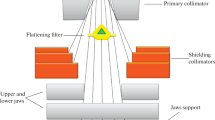Abstract
Dose-averaged linear energy transfer (LETd) is conventionally evaluated from the relative biological effectiveness (RBE)-LETd fitted function used in the treatment planning system. In this study, we calculated the physical doses and their linear energy transfer (LET) distributions for patterns of typical CIRT beams using Monte Carlo (MC) simulation. The LETd was then deduced from the MC simulation and compared with that obtained from the conventional method. The two types of LETd agreed well with each other, except around the distal end of the spread-out Bragg peak. Furthermore, an MC simulation was conducted with the material composition of water and realistic materials. The profiles of physical dose and LETd were in good agreement for both techniques. These results indicate that the previous studies to analyze the minimum LETd in CIRT cases are valid for practical situations, and the material composition conversion to water little affects the dose distribution in the irradiation field.





Similar content being viewed by others
Data availability
The authors declare that the data supporting the findings of this study are available within the paper.
References
Tobias CA, et al. Radiological physics characteristics of the extracted heavy ion beams of the bevatron. Science. 1971;174(4014):1131–4. https://doi.org/10.1126/science.174.4014.1131.
Hirao Y, et al. Heavy ion synchrotron for medical use—HIMAC project at NIRS-Japan—. Nucl Phys A. 1992;538:541–50. https://doi.org/10.1016/0375-9474(92)90803-R.
Kamada T, et al. Carbon ion radiotherapy in Japan: an assessment of 20 years of clinical experience. Lancet Oncol. 2015;16(2):e93–100. https://doi.org/10.1016/S1470-2045(14)70412-7.
Yanagi T, et al. Dose–volume histogram and dose–surface histogram analysis for skin reactions to carbon ion radiotherapy for bone and soft tissue sarcoma. Radiother Oncol. 2009;95(1):60–5. https://doi.org/10.1016/j.radonc.2009.08.041.
Okonogi N, et al. Dose-averaged linear energy transfer per se does not correlate with late rectal complications in carbon-ion radiotherapy. Radiother Oncol. 2020;153:272–8. https://doi.org/10.1016/j.radonc.2020.08.029.
Matsumoto S, et al. Unresectable chondrosarcomas treated with carbon ion radiotherapy: relationship between dose-averaged linear energy transfer and local recurrence. Anticancer Res. 2020;40(11):6429–35. https://doi.org/10.21873/anticanres.14664.
Mohamad O, et al. Risk of subsequent primary cancers after carbon ion radiotherapy, photon radiotherapy, or surgery for localised prostate cancer: a propensity score-weighted, retrospective, cohort study. Lancet Oncol. 2019;20(5):674–85. https://doi.org/10.1016/S1470-2045(18)30931-8.
Hagiwara Y, et al. Influence of dose-averaged linear energy transfer on tumour control after carbon-ion radiation therapy for pancreatic cancer. Clin Translational Radiat Oncol. 2020;21:19–24. https://doi.org/10.1016/j.ctro.2019.11.002.
Kanematsu N, et al. Estimation of linear energy transfer distribution for broad-beam carbon-ion radiotherapy at the national institute of radiological sciences, Japan. Radiol Phys Technol. 2018;11:242–7. https://doi.org/10.1007/s12194-018-0444-7.
Anakura M, et al. Improved algorithm for estimation of linear energy transfer in carbon ion radiotherapy plans. Anticancer Res. 2023;43(7):2975–84. https://doi.org/10.21873/anticanres.16468.
Kanai T, et al. Biophysical characteristics of HIMAC clinical irradiation system for heavy-ion radiation therapy. Int J Radiat Oncol Biol Phy. 1999;44(1):201–10. https://doi.org/10.1016/S0360-3016(98)00544-6.
Sato T, et al. Features of particle and heavy ion transport code system (PHITS) version 3.02. J Nucl Sci Technol. 2018;55(6):684–90. https://doi.org/10.1080/00223131.2017.1419890.
Furuta T, et al. Development of the DICOM-based monte carlo dose reconstruction system for a retrospective study on the secondary cancer risk in carbon ion radiotherapy. Phys Med Biol. 2022;67: 145002. https://doi.org/10.1088/1361-6560/ac7998.
ATIMA. https://web-docs.gsi.de/~weick/atima/ Accessed 16 May 2023.
Iida K, et al. Formula for proton-nucleus reaction cross section at intermediate energies and its application. J Phys Soc Jpn. 2007;76(4): 044201. https://doi.org/10.1143/JPSJ.76.044201.
Chang W, et al. Technical note: validation of a material assignment method for a retrospective study of carbon-ion radiotherapy using monte carlo simulation. J Radiat Res. 2021;62(5):1–10. https://doi.org/10.1093/jrr/rrab028.
ICRP, Adult Reference Computational Phantoms, ICRP Publication 110, Ann. ICRP, Vol. 39, No. 2 (2009)
Schneider W, et al. Correlation between CT numbers and tissue parameters needed for Monte Carlo simulations of clinical dose distributions. Phys Med Biol. 2000;45:459. https://doi.org/10.1088/0031-9155/45/2/314.
Parodi K, et al. Patient study of in vivo verification of beam delivery and range, using positron emission tomography and computed tomography imaging after proton therapy. Radiat Oncol Biol Phys. 2007;68(3):920–34. https://doi.org/10.1016/j.ijrobp.2007.01.063.
Paganetti H, et al. Clinical implementation of full monte carlo dose calculation in proton beam therapy. Phys Med Biol. 2008;53:4825. https://doi.org/10.1088/0031-9155/53/17/023.
Kry SF, et al. AAPM TG 158: Measurement and calculation of doses outside the treated volume from external-beam radiation therapy. Med Phys. 2017;44(10):e391–429. https://doi.org/10.1002/mp.12462.
Author information
Authors and Affiliations
Corresponding author
Ethics declarations
Conflict of interest
The authors declare they have no conflict of interest for this study.
Ethics approval
All procedures involving human participants were performed in accordance with the ethical standards of the Institutional Review Board (IRB) and the 1964 Helsinki Declaration and its later amendments or comparable ethical standards. Ethical approval was not required for this study.
Additional information
Publisher's Note
Springer Nature remains neutral with regard to jurisdictional claims in published maps and institutional affiliations.
About this article
Cite this article
Ishikawa, A., Koba, Y., Furuta, T. et al. Monte carlo simulation study on the dose and dose-averaged linear energy transfer distributions in carbon ion radiotherapy. Radiol Phys Technol (2024). https://doi.org/10.1007/s12194-024-00798-7
Received:
Revised:
Accepted:
Published:
DOI: https://doi.org/10.1007/s12194-024-00798-7



